Back in the fall, I posted about collecting seeds from the trees I encountered while I was in the city for work. Through my travels, I collected acorns, apple seeds, and Ohio Buckeye nuts.
At first, I just had them sitting on the kitchen counter in paper coffee cups but I knew this wasn't a good long-term solution, especially if I wanted them to survive over winter. After a little research, I learned that acorns needed to be kept damp and chilled to maintain their viability.
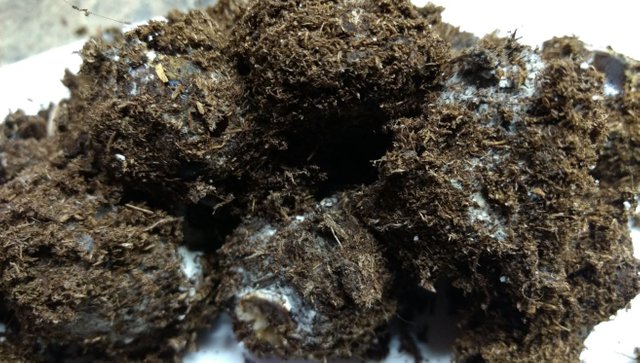 Ohio Buckeye seeds coated with fungus.
Ohio Buckeye seeds coated with fungus.Unfortunately, the same damp and chilly conditions that they stored well at also provided the stratification they needed to germinate. Most of the articles I read on propagating oaks from acorns said about 60 days at 40°F was sufficient for stratification.
The information on storing Buckeye's was a little harder to find and I didn't come across many good articles regarding proper storage. One thing that was clear though, was that they also needed to be kept moist.
Since my life has been super hectic for many months now, storing acorns and buckeyes was put off for quite awhile and then, when I finally got around to it, I just rushed through the process. Normally, it isn't in my nature to rush projects, I like to research, think, and then formulate a plan. In this case though, I just had to do it on the fly otherwise it just wouldn't get done.
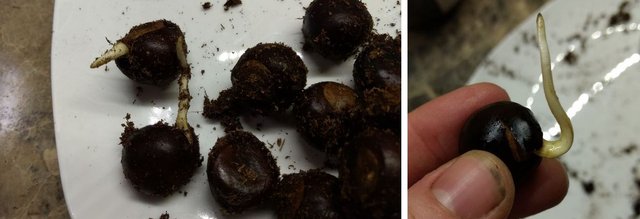 Several of the Buckeyes have sprouted already and I have no idea what to do with them.
Several of the Buckeyes have sprouted already and I have no idea what to do with them.The articles I read suggested using damp sand or sawdust to store the acorns, probably because these are relatively sterile substrates and there is less of a chance for molds and funguses to infect your seeds. All I had lying around though was peat moss. I found some small containers, filled them with peat moss, and put both the acorns and buckeyes in them. They had lids so I either poked small holes in them or left them slightly ajar.
A few weeks ago I checked the containers and everything seemed fine. By stirring them up, however, I brought the seeds to the surface and I was worried that they might dry out too much. Pushing them down was difficult to do without putting excessive pressure on the other seeds below. I didn't have any peat at this time but I did have some potting mix which is mostly peat so I figured using it as a top layer over the seeds would be fine.
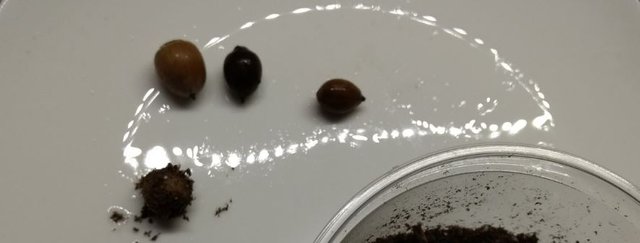 The acorns seem fine. No signs of fungus.
The acorns seem fine. No signs of fungus.Well, I checked on the buckeyes again last night and I encountered a large rubbery mass surrounding about half of them. At first, I thought it was mold and I was super worried that my substrate was too wet and I had killed all of my seeds. After closer inspection, however, it appeared that the white stuff was some sort of fungus.
That is when it dawned on me that this potting mix had mycorrhizae in it! I had unintentionally inoculated my seeds with some sort of fungus. At this point I decided to empty all my containers to see what was going on. I had no idea whether or not I had ruined my buckeyes. I was also concerned about the state of my acorns as well.
After emptying the containers, I was relieved to find that only the buckeyes had the mycorrhizae on them. I was able to peel it off and most of the buckeyes seem to have remained intact underneath so I am unsure what exactly the fungus is feeding on. Could the buckeyes be releasing some sort of exudate that it is feeding on?
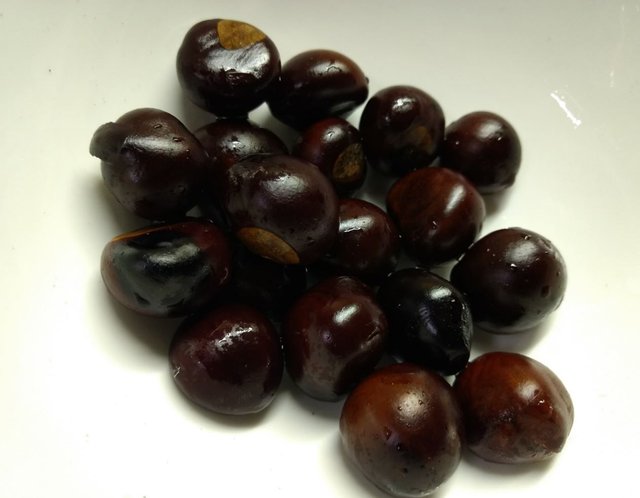 About half the buckeyes seemed unaffected by the fungus.
About half the buckeyes seemed unaffected by the fungus.I also discovered that three of the buckeyes had sprouted. The good news is, I know that at least some of them are viable but the bad news is our winter is super long and spring won't be here for a few more months. I am really not sure what to do with them.
I rinsed off the buckeyes that didn't seem to be affected by the fungus to make sure they were alright and they still looked about the same as when I put them in the containers. I also rinsed a few of the acorns off and they looked fine also. None of the acorns have sprouted yet.
I decided to put the buckeyes with the fungus back into the original container. I am curious to see if they still germinate even though they are covered in a rubbery layer. I put the rinsed buckeyes into a new container, hopefully they aren't contaminated. The acorns I just put back in the original containers because they seemed fine.
Now the question is what do I do with the sprouted buckeyes? Do I plant them now and try to coddle them inside until I can put them out in the spring? Do you think I have ruined the other seeds?
If you have any comments or suggestions I am all ears! I just hope that I can get a handful of Ohio Buckeyes and Oaks out of this mess.
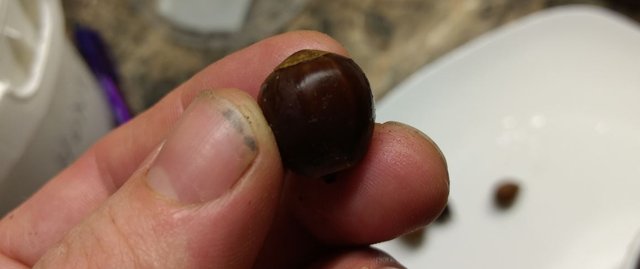 I also rinsed off a few acorns and they seem fine, as far as I can tell.
I also rinsed off a few acorns and they seem fine, as far as I can tell.Sources:
https://dnr.wi.gov/education/documents/StepbyStep.pdf0176
http://www.uky.edu/hort/propagation-ohio-buckeye
OKay, I am absolutely no expert. Totally guessing here.
First of all, you collected these from random trees. It is hard to know exactly what fungus they would be unless they grow more. However, you could look more into what types of mycelium like those particular trees. Probably not, BUT, some edible mushrooms that you would possibly see would be shitake, oyster, turkey tail, reishi, and lion's mane. It could be simply because you grabbed some nuts that had fallen on some ground with a lot of spores. The presence of fungi might actually be a good sign. As long as its not mold fungus. If it's from one of the edible types and you remember where you found those seeds, might be a good place to return to forage for some shrooms.
Either way, if it is an edible mushroom or another type of mycelium, something to remember is that the mycelium that is in the soil serve a function. That function might be to help decompose that outer shell to help allow the nuts to sprout. The shells are thick, afterall.
Why are they sprouting so soon? Maybe in the wild they are covered by a thicker layer of soil, leaves, branches, etc, that takes longer for the sprouts to make it to the light. Maybe they have been kept a little too moist in too warm of an area with too much light. Maybe the temperature has not been cold enough for long enough. Maybe there is absolutely nothing abnormal about them sprouting now. It might take a long time after they sprout to really get established.
I would put them all in one big sprouting container in soil. Forrest loamy soil, possibly. After they get big enough, transplant into pots then slowly harden them off (i think). They are going to be really small so if you plant them right in the ground, they might or might not survive. Afterall, there must be some reason in the wild so many nuts/seeds are produced. Imagine if every one survived? Anywaym if you grow them a year or two inside pots, they will be stronger with more likelihood for success next spring. Growing them as a nursery would. Once reason when you buy fruit bushes and trees from nurseries, you rarely get younger than 2 yr old plants. Sprouting is one thing, but surviving after sprouting is another.
There was my total guess, observation, and advice. Hope that was helpful. That'll be $100 steem. haha =p
Downvoting a post can decrease pending rewards and make it less visible. Common reasons:
Submit
Thanks for the lengthy reply :)
You are right that it could also be a fungus that was on the nuts to begin with. Although I have no idea what it might be. I don't think it is any sort of mold. I forgot to take a picture of it but I could peel the fungus off the buckeyes in a layer. It was very rubbery like cooked egg white.
I may have had the medium too moist and that triggered the spouting maybe. The articles say things like moist or slightly moist but don't really tell you how to achieve it.
I also found out today from one the articles that the buckeyes could be kept in a sealed baggy for up to 4 months which is probably what I should have done.
I am think I will end up trying to plant the sprouted seeds but haven't really figured out the logistic of that yet. There isn't a lot of room in the Tiny House.
Downvoting a post can decrease pending rewards and make it less visible. Common reasons:
Submit
the picture reminds me of turkeytail, lionsmane, or reishi mycelium which i think like decaying oaks. i have hazelnuts in the freezer right now. i should take them out soon. you could keep them inside a couple weeks maybe then plant them since room is tight? or plant them now? or just toss them somewhere randomly.
Downvoting a post can decrease pending rewards and make it less visible. Common reasons:
Submit
I hope you are right and it is some sort of edible mushroom or at least something beneficial.
I kept the Buckeyes that have the fungus so I am curious to see what happens.
Downvoting a post can decrease pending rewards and make it less visible. Common reasons:
Submit
here is a link showing how some homegrown lion's mane looks as the mycelium is beginning to grow. from the reishi and turkey tail growing on our property where we had some oaks cut down, chipped into mulch, then left there, they appear to have similar mycelium growth to lionsmane before it fruits into the mushrooms. The big problem with mushrooms in the wild is nature is not a sterile environment. there are probably a lot of different fungi and bacteria scattered about objects laying on the ground. anywhooo, here is the link. that white stuff in the first picture is the mycelium beginning to grow. at the very beginning, it is sparse but can be seen within the substrate if broken apart, and too me, looks similar to your first picture having grown them in a kit myself. It is rubbery like an overcooked hardboiled egg.
http://biol213-plants1.blogspot.com/2016/04/mane-mushroom-patch-pilobolus-culture.html
Downvoting a post can decrease pending rewards and make it less visible. Common reasons:
Submit
Thanks for the link.
Downvoting a post can decrease pending rewards and make it less visible. Common reasons:
Submit
I would go ahead and pot them up in four inch or 1 gallon sized nursery pots. I would give them a tiny bit of water and keep them in a cool area of the home until they leaf out. Keep them in the coldest possible place without freezing until you can plant them outdoors
Downvoting a post can decrease pending rewards and make it less visible. Common reasons:
Submit
I wonder if I could put them in pots and just leave them in the fridge?
Alternatively the corner of the pantry is fairly cool this time of year because it doesn't get much air circulation and there are two outside walls.
That sounds like a good idea.
Downvoting a post can decrease pending rewards and make it less visible. Common reasons:
Submit
Hope you get to the bottom of this! ;)
Downvoting a post can decrease pending rewards and make it less visible. Common reasons:
Submit
me too! ;)
Downvoting a post can decrease pending rewards and make it less visible. Common reasons:
Submit
Ok, so I am also no expert on when to plant those buckeyes, but I am fairly certain that what you're looking at is not fungus, but a curse.
Tell me, have you run over any gypsies or built tiny houses on top of Indian burial grounds lately?
Downvoting a post can decrease pending rewards and make it less visible. Common reasons:
Submit
Well, I hit something yesterday but I didn't stop to see what it was.....
Downvoting a post can decrease pending rewards and make it less visible. Common reasons:
Submit
hahaha omg Best comment I've read today!
Downvoting a post can decrease pending rewards and make it less visible. Common reasons:
Submit
I think it's really cool that you collected seeds. I am no help on what's going on with them, but, I am excited to see this progress!
Downvoting a post can decrease pending rewards and make it less visible. Common reasons:
Submit
Thanks, I am really enjoying it. It is sort of like an experiment!
Downvoting a post can decrease pending rewards and make it less visible. Common reasons:
Submit
I have never paid much attention to the nuts that are n the ground. Maybe I should be.
I wish had the answer and could help you.
Downvoting a post can decrease pending rewards and make it less visible. Common reasons:
Submit
It's all good. I'll see what happens and there will probably be an update so we can all learn together. Thanks for stopping by!
Downvoting a post can decrease pending rewards and make it less visible. Common reasons:
Submit
Your article is very best. In which the description of seeds is well done. We have received a lot of information about this.
Downvoting a post can decrease pending rewards and make it less visible. Common reasons:
Submit
I hope so 😉
Downvoting a post can decrease pending rewards and make it less visible. Common reasons:
Submit